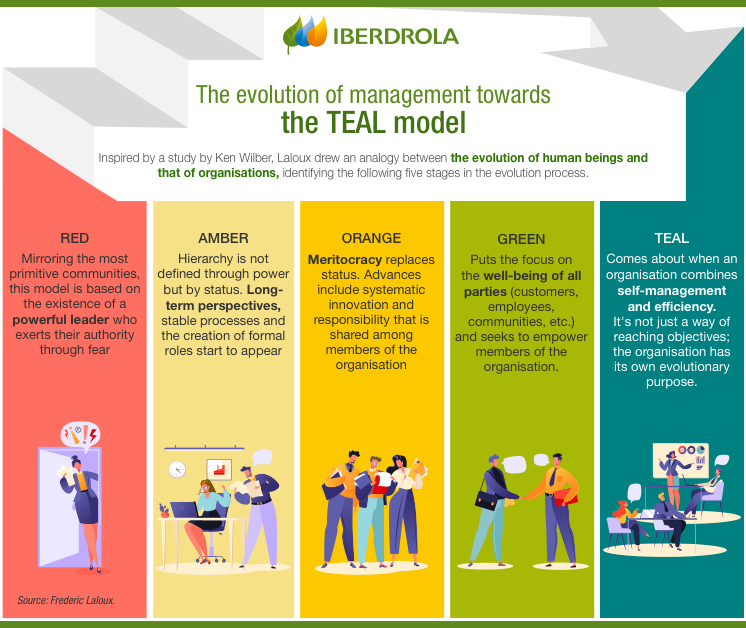TEAL organisations
TEAL organisations: how do they reinvent management and what are their advantages?
TEAL organisations are based on the eponymous paradigm created in 2014 by a former McKinsey & Company executive, Frederic Laloux, after years of searching for a more efficient organisational model. Their main objective is to leverage the talents of employees, who complement each other, by pooling their knowledge and integrating at all levels.

Teal is the colour used by Frederic Laloux, a former associate partner with consulting firm McKinsey & Company, to identify a type of organisation that eschews hierarchical and organisational structures and embraces current social and employment trends. This led him to develop a new organisational concept based on three key ideas: self-management, wholeness and evolutionary purpose. To implement this concept, finding the convergence point between maximum operational efficiency and employee satisfaction becomes key.
What are TEAL organisations
Less than a decade ago, Laloux, feeling dissatisfied and unmotivated at work — something that thousands of employees across the world can identify with — quit his job and began researching organisational models that combined productivity with personal well-being. And he found one. In 2014, he published his analysis in the form of a book called Reinventing Organizations in which he used the term TEAL for the first time to refer to a new, healthier type of organisation that is constantly adapting to the present.
So how can we define TEAL organisations? TEAL organisations are centred on human capital. They simplify hierarchisation and attach less importance to control, fostering a sense of responsibility among their workers and offering them continuous opportunities for training and professional and personal development.
The pillars of TEAL organisations and their advantages
Teal organisations are based on three pillars:
 Self-management
Self-management
They don't need hierarchies, unlike traditional organisations. They embrace decentralisation — which does not imply disorder — and the responsibility for making decisions is shared, as trust is placed in employees' individual and collective intelligence. So, does that mean there are no bosses? Not in the traditional sense. Instead, there are a series of coordination mechanisms.
 Wholeness
Wholeness
Workers are encouraged to develop not only as professionals, but as human beings. TEAL organisations therefore take the emotional aspect into account to make each member of the team feel as good as possible. This increases employees' commitment, sense of belonging, proactivity and creativity, there by maximising their potential.
 Evolution
Evolution
They are constantly adapting and striving to evolve. All members are encouraged to become familiar with what the organisation wants to be and what its purpose is in a process of observation, exploration and discovery in which everyone participates.
What advantages do TEAL organisations have? There are three main advantages. The first is the human factor. Putting people at the heart of the company makes employees feel committed, motivated and at ease. The second is learning. TEAL organisations are a source of constant knowledge where there are no fears about making mistakes and where personal initiative is stimulated. The third is an integrated view of success. This means that individual progress is considered as progress for the company as a whole.

SEE INFOGRAPHIC: The evolution of management towards the TEAL model [PDF] External link, opens in new window.
How to reinvent your organisation
It's not easy to change a company's traditional structure. To become a TEAL organisation, the transformation should be approached from multiple levels:
- Propose a new work structure.
- Renew employees' mentality, habits and way of working.
- Promote intergenerational integration and complementary talents.
- Highlight the importance of people and rally around a purpose.
- Make use of new technologies to create added value.
- Construct more flexible environments to discover and develop employees' potential.
- Accept control, independence and responsibility at all levels.
- Encourage agile decision-making and transparent information management.
Examples of TEAL organisations
Applying the TEAL model works, as these companies have shown:
- Buurtzorg. This Dutch home-care organisation was founded in 2007 and grew exponentially in just ten years, while at the same time achieving the best customer satisfaction scores. The company operates using 1,000 autonomous, self-managed teams that take care of the whole healthcare process.
- Zappos. The founder of this US clothing and footwear company, Tony Hsieh (who recently passed away), opted for a horizontal organisation. The key idea was self-management based on roles that are distributed into 'circles' dedicated to specific functions. He caused controversy when he asked employees to commit to the new model, as some of them decided to leave.
- Morning Star. One of the world's biggest tomato processing companies, it operates without any hierarchy, since the workers report directly to their colleagues. Its commitment to this model is such that in 2008, it created the Self-Management Institute with the aim of conducting research and teaching its practices to other organisations.




